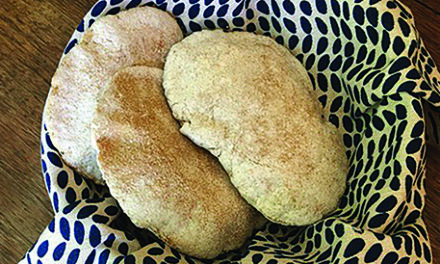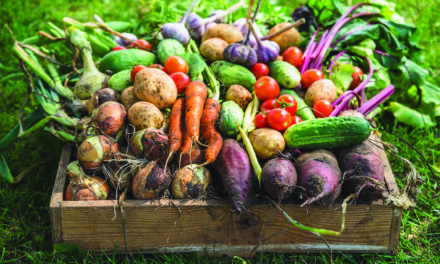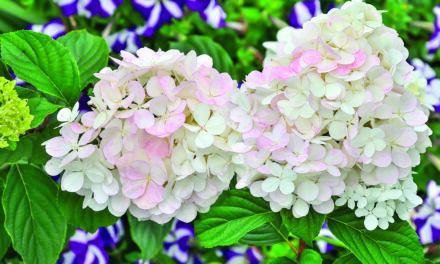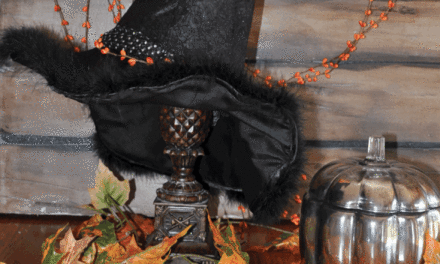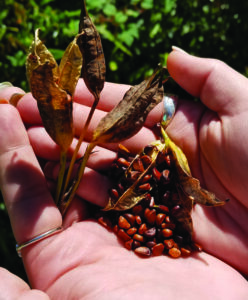
Eastern Shore Seed Stewards encourages collecting and growing additional types of native plant seeds in home gardens, like blue flag iris, then donating a percentage of seeds to Environmental Concern. (Photo courtesy Environmental Concern)
As summer settles into fall, it’s tough to let go of that urge to garden.
Becoming a seed saver could channel that energy and preserve plant diversity.
For those on a budget, seed saving requires minimal cost and saves spending money buying seeds. It also helps conservation minded gardeners contribute to less waste.
Kathy Jentz, editor of Washington Gardener Magazine, initiated National Seed Swap Day in 2014 and coordinates annual seed exchanges the last Saturday each January.
To anyone wondering why bother saving all those tiny seeds, Jentz readily replies, “Thriftiness—no need for anything in your garden to go to waste. Compost, recycle, and re-use.”
She cites frugality as another reason. “Why buy new plants every year when you can grow your own for free?” she said. “And why buy unproven plants and seeds when you know the ones you’re collecting did well and obviously flourished in your yard?”
Seed saving also helps ensure the continued presence of heirloom and rare varieties, she pointed out. “Commercial growers and catalogs will often only carry the most popular plants and seeds,” Jentz noted. By gathering more diverse specimens than these ‘top growers’, gardeners play a vital role ensuring genetic diversity going forward.
Mikaela Boley, University of Maryland Extension Sr. Agent Associate, Urban Horticulture, and Master Gardener Coordinator, in August led a hands-on seed saving workshop with the Talbot County Free Seed Library at the Talbot County Public Library in Easton, along with a second, virtual program online. Scheduled for Sept. 10 beginning at 10 a.m., the workshop will cover easy-to-save species and go over methods of cleaning and storage. Visit go.umd.edu/seedsaving to register. For more information, call 410-822-1244 or e-mail mboley@umd.edu.
To help those starting out, the workshops focus on learning the basics, covering “easy-to-save” species, especially native plants.
“A lot of flowers and native plants are easy species to begin with; wild columbine (Aquilegia canadensis) is a great native flower, as well as our native blue flag iris (Iris versicolor). Native grasses also germinate very well from seed. Ornamental varieties that are easy to save include: cosmos, zinnias, dill, nasturtiums, bachelor’s button, marigolds, and sunflowers. There are a lot more, but those are easily recognizable and accessible,” Boley added.
Master Naturalist Reenie Rice agrees that wildflowers and native grasses are best for seed collectors, as they’re most likely to produce a plant resembling its parents.
“The parent plants of cultivars can be astonishingly different from the highly bred progeny. Wildflowers are more predictable,” she said, citing examples such as Milkweed, Black Eyed Susan, Purple Coneflower, Asters, Bee Balm, Lupine, Cardinal Flower, Wild Petunia, Moutain Mint, and more.
The quest for Milkweed seed launched another local seed saving enterprise. In 2018 St. Michaels nonprofit Environmental Concern founded Seed Stewards for Monarchs. According to president Suzanne Slear, over 250 volunteers currently participate, helping increase the Monarch butterfly’s critical Milkweed habitat and seed inventory for Environmental Concern’s Milkweed crops.
It’s extension outreach program, Eastern Shore Seed Stewards, encourages collecting and growing additional types of native plant seeds in home gardens, then donating a percentage of seeds to Environmental Concern. For more information on the program, visit www.wetland.org.
Boley suggests that before heading out on your own seed collecting mission, think about your desired plant type (annual, bienniel, or perennial) and planting location. Also be sure to consider the legal and ethical boundaries regarding where and how much to gather.
For instance, many public parks have ordinances against wild foraging. Boley mentioned the cautionary tale of a National Park ranger warning off a visitor stowing edible specimens in a large trash bag. And roadsides present safety hazards.
Private property, with permission granted is the easiest route. Rice agreed, advising prospective seed savers to bear in mind that “walking across someone else’s land without permission is called Trespassing. Don’t do it.”
Boley reminded eager gatherers to follow the “20” rule; that is, for every 20 specimens take only 1. Also, be careful not to pick rare or endangered plants (a list is available online at https://dnr.maryland.gov/wildlife/Documents/rte_Plant _List.pdf.
Rice agreed that its crucial to prevent precious seed stock from disappearing. On the other hand, collecting from a soon to be cleared vacant lot or fallow field, might help save it, she said.
Cultivating patience is a good idea for gathering, Boley noted. A general rule of thumb is to let seed pods/heads mature on the plant six to eight weeks after they finish flowering.
One common beginner’s mistake is cutting the seed heads while still green, or immediately after finished blooming. “Because seed heads can look way different than the flower,” she suggested putting marking tape and flags by intended specimens ahead of time.
To stay on top of the timing, Jentz advised checking on seed pods every few days. “They are ready when the pods are dry, brittle, and just ready to open. Don’t wait too late or they’ll break open on their own and cast their seeds to the wind,” she added.
It’s best to pick when there’s no rain, no wind, and mid-morning after the sun has dried residual air moisture and leafy dew drops, Jentz noted. And collecting can be as simple as placing a piece of paper underneath and shaking them gently.
Among Boley’s favorite collection “hacks” is placing a mesh organza drawstring bag, often used to hold wedding favors, atop the seed head prior to gathering. But tied paper lunch bags and even pillowcases can work she advised.
To clean the freshly gathered seeds, Boley places fresh newspaper beneath each separate variety to remove chaff (any ‘non seed’ material from leaves to dirt to bugs).
For more thorough sorting, she uses a mesh sieve made from purchased screening which her husband framed with wood.
To store, make sure seeds are totally dry before placing into tightly closed jars or zipper-closed baggies in a cool, dark, dry place, Jentz advised. (Boley likes using coin envelopes, which are especially nice for giving seeds as gifts.)
Just make sure you’ve labeled each specimen with date and variety as specifically as possible, she added. “Next spring, you’ll be very glad you did, as many seeds look alike.”
To save several steps, Rice recommended planting seeds just after collecting. “That’s what nature would do! The cold weather, ongoing freezes and thaws, all help seeds germinate. Let nature break open that seed coat that gave such strong resistance when you tested it. Then, in spring, just look online for pictures of your wildflower seedlings so you’ll recognize them when they spring up,” she added.
For those intrigued to start saving seeds, with specific questions about native species, Boley is “more than happy to serve as a resource.” For more information, contact her at mboley@umd.edu.

